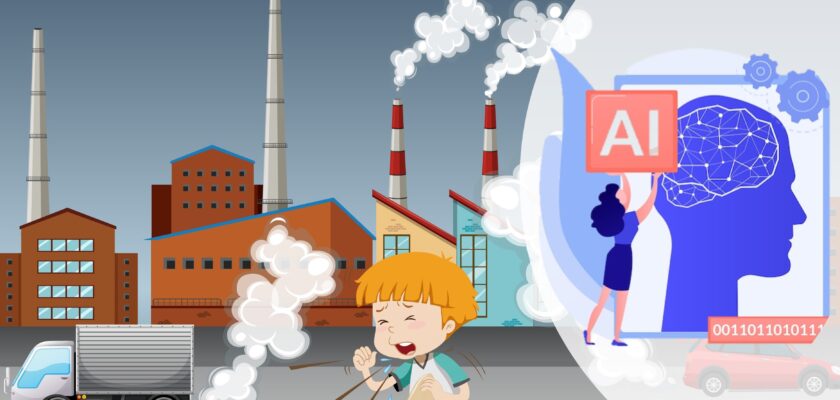AI has the power to solve some of the world’s most complex problems, like pollution. One of the most significant environmental challenges we face today is pollution, a growing concern that scientists and researchers are scrambling to resolve. Because of constant innovation and technological upgrades, researchers now have better and more powerful tools for analyzing vast quantities of data.
Latest advances in AI and IoT have made it possible for cities to digitize vehicle and transit systems, reduce congestion, improve security, and save lives.
Traffic pollution does not usually contribute to the bulk of emissions in many countries. Intercity passenger transport only contributes about 9% to 17%. However, this percentage varies significantly from country to country. Many countries are now giving more importance to controlling emissions from traffic hubs and intersections.
AI ML to Control and Reduce Pollution
Machine Learning could help pinpoint traffic hazards and bottlenecks. In cities, there is no shortage of pollution. However, a new gadget based on machine learning discovers problems and provides solutions. This gadget combines an AI with a GPS tracker to find data that shows the source of pollution and its severity.
As Global Pollution Action Summits (GPAS) continue to reduce pollution worldwide, many primary methods are working to lessen congestion and increase efficiency in a city’s infrastructure, including traffic flow and vehicle emissions. But, again, artificial intelligence leads the frontlines in the battle against pollution.
Vehicle Emissions
Vehicles stop, idling as they wait for signal lights to change and accelerate, wasting fuel and polluting air. According to DOE estimation, if cars idle for more than 30 seconds every hour. They waste about 6 billion gallons of gasoline and diesel.
City authorities typically measure air pollution at expensive monitoring stations to install, maintain, and only provide information about a few square kilometers. Now researchers in many countries have used machine learning to analyze tweets for clues about what air is like on a fine-grained level within a radius of 300 meters.
Environmental conservation is a big issue in many countries. By 2035, many governments plan to have all cars electric. Still, some companies are already looking into ways that they can help with this process. The issue is that most people don’t even know that they might be contributing more to pollution than they think.
With growing urgency around pollution and congestion in metropolitan areas, governments are looking to find solutions with the help of AI. For example, there is an AI-powered network of sensors that measures emissions from cars.
This way, cities can find drivers who are polluting too much. Other cities have their own data collection systems that measure pollution levels in the air.
IT researchers are using machine learning algorithms to analyze a vast amount of data about travel patterns in Seattle. The results show that making targeted adjustments to the city’s traffic lights can significantly reduce transit times. Hence, people spend less time in traveling vehicles and save gas.
Last year, the DOE awarded $1.89 million to researchers at University of Tennessee-Chattanooga to find a better way. Researchers from University of Pittsburgh, Georgia Institute of Technology, Oak Ridge National Laboratory, and City of Chattanooga. Joined forces to develop a new model for traffic intersections that reduces energy consumption and improves traffic flow.
The project aims to decrease fuel consumption in corridors by 20%, an amount that would save trillions of dollars and trillions of gallons of fuel every year.
While keeping the transportation environment safe and efficient. In addition, researchers plan to use artificial intelligence and machine learning in smart transportation applications. In an account from GCN.com, Pitt officials said that the project will also include emergency vehicle preemption, transit signal priority, and pedestrian safety features.
Our cars and cell phones have combined to make driving safer.
New traffic-management systems have made urban driving less stressful in some cities. The upcoming step in their evolution is to merge these systems through artificial intelligence. According to Aleksandar Stevanovic, director of Pittsburgh Intelligent Transportation Systems Lab (PITS), there’s plenty of room for new technologies on our city streets.
A system for creating such a map, especially in dense urban corridors and sprawling exurbs, can significantly reduce energy and ecological impacts. However, he said, noting that gasoline-powered vehicles will be a primary source of transportation for some time.
Oak Ridge National Laboratory is testing a system that uses cameras and sensors on roadway to identify and track gas-guzzling commercial trucks in traffic. First, AI and machine learning algorithms identify the fleet’s least-efficient vehicles. They will follow their path and speed to adjust traffic lights up ahead. This will allow you to avoid excessive gas consumption by eliminating unnecessary stops and starts at intersections. Since right turns are made only at a few crossroads, cars do not need to stop repeatedly at each meeting, and fuel consumption is minimized.
A smart corridor built from a 2014 partnership between Oak Ridge National Laboratory and Chattanooga’s Electric Power Board (EPB) will serve as a testbed for experimental energy technologies.
The corridor employs cameras, LIDAR, radar, wireless communications, and air quality and audio sensors. These devices collect information from their spots on poles along 10 Martin Luther King Boulevard blocks. A 10 Gbps fiber network enables real-time data transmission in a smart city testbed.
AI Cameras Will Be Everywhere.
According to a new report by Smart Cities World, smart cameras installed on traffic lights will transform the way we manage our city roads by 2025. The cameras will make it possible to apply computer vision solutions to various applications, including pedestrian detection and alerting. By 2025, IT company projects will have more than 155,000 AI-based cameras used, up from 33,000 in 2020.
In a report on Edge Analytics in Smart Cities and Intelligent Transportation, advanced traffic management applications include adaptive traffic lights, vehicle prioritization, parking access and detection, and electronic toll collection.
According to Dominique Bonte, a vice president of ABI Research, camera system revenue will grow from $46M in 2020 to $189M in 2025. Smart cameras with advanced processors are becoming more popular as neural net software frameworks from silicon vendors like Intel, Nvidia, and Qualcomm become more widely available, “Legacy traffic and ETC sensors such as magnetic loops and RFID have higher price points compared to new technology such as video detection,” stated by Dominique Bonte.
A low latency computer network processes messages quickly and without much delay. In a few years, you’ll be able to experience standard latency analytics on the edge of telco networks. ABI Research predicts that edge cloud will give rise to new classes of applications operating in larger service areas.
Include:
- Cooperative adaptive traffic lights and remote traffic management can improve road intersection management.
- Safety and security operations include crowdsourced hazard and security alerts and remotely controlled response management systems installed on street furniture.
- Autonomous asset management, remotely controlling driverless vehicles and robots.
Bonte emphasized that edge cloud will not replace existing roadside infrastructure but will work with it to create more holistic solutions.
Texas A&M Researchers Train Deep Neural Network to Control Signals
Researchers from Texas A&M University are using reinforcement learning to study traffic management. The team is trying to make decisions that will improve operations by applying learning algorithms that reward favorable outcomes. This reduction in traffic buildup also has the effect of reducing traffic delays.
Accounts in a Futurity report: The model uses a deep neural network (DNN) and a machine-learning algorithm. But unfortunately, they are inconsistent in their decision-making, making it challenging to work with them. So said Guni Sharon, a professor in the Department of Computer Science and Engineering at Texas A&M University.
To overcome this, Sharon and his team developed a new algorithm that allows deep neural networks to be trained in real-time as they observe the world.
The team created a simulation of a natural intersection to test their approach. They found that their methodology worked well. With adaptive signal control technology, a reduction in vehicle delay of up to 19.4% can be made compared to commonly deployed devices. Researchers found it took the controller two days to understand which actions helped minimize traffic and reduce traffic congestion.
Our future work aims to mine the experience of already deployed controllers to jumpstart our own learning process, Said Sharon.
The world’s pollution levels are rising, with the atmosphere reaching harmful levels for humans and other living beings. Recent reports find that humans are consuming more energy than ever. This trend is set to increase rapidly in coming years.
As we try to figure out how to adapt to an ever-increasing population and pollution levels, one solution that has gained momentum is artificial intelligence (AI) technology. Using sensors and algorithms based on machine learning, AI can help us reduce our carbon footprint and improve living conditions for all of us.

